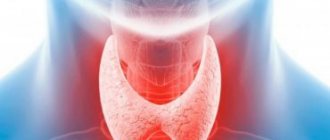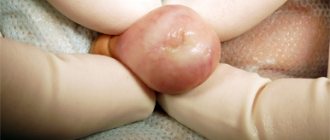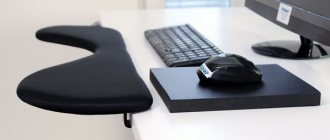Thyroiditis
is a medical term for inflammation of the thyroid gland.
In the practice of an endocrinologist you can find the following varieties:
- Chronic autoimmune;
- Subacute;
- Spicy.
In this article we will look at the second type. It is also called De Quervain's thyroiditis or granulomatous.
Why is thyroiditis dangerous?
Subacute thyroiditis is caused by viruses that cause destructive (destructive) damage to the thyroid gland. It is characterized by a 4-phase flow. Patients report severe pain in the neck area and symptoms of acute infection.
Subacute thyroiditis accounts for approximately 5% of all thyroid pathology. More often diagnosed in women. It is registered in various age groups, but the peak incidence occurs between 30-60 years. It also has seasonality (autumn, summer).
Subacute thyroiditis
According to ICD 10, this disease has code E06.1. The disease is described as inflammation of the thyroid gland, resulting in the formation of granulomas (nodules) in the tissues.
Today, scientists suggest that subacute thyroiditis is based on a viral infection, which provokes the formation of granulomas, however, there is no evidence for this theory. Most often it occurs in women of childbearing age (from 20 to 50 years). Men, children and the elderly are practically never diagnosed with this diagnosis.
The disease does not last long, but exacerbations (relapses) occur quite often.
There are two types of disease:
- de Quervain's thyroiditis - occurs after a viral infection;
- lymphocytic - antibodies to thyroid tissue can be detected; it often occurs in women after childbirth, and then this thyroiditis is called postpartum thyroiditis.
The focus of inflammatory changes in the gland is usually small and does not occupy the entire lobe. Under the influence of inflammatory processes, thyroid follicles can be damaged or ruptured. As a result, a large amount of thyroid hormones is released.
Pathogenesis
Granulomatous infiltration of giant cells develops in the gland tissue in response to the introduction of the virus. The formation of giant cells is characteristic of autoimmune processes, and in some patients, autoantibodies to the thyroid gland appear in the blood. This fact indicates the presence of secondary autoimmune mechanisms in this disease. The introduction of the virus into a thyroid cell is accompanied by its destruction, while the contents of the follicle enter the blood and, against the background of destruction, thyrotoxicosis . Subsequently, the function of the gland is restored and temporary thyrotoxicosis is replaced by hypothyroidism and normalization of function (euthyroid state).
Subacute thyroiditis. Symptoms
The symptoms of the pathology are vague and can be confused with other diseases of the endocrine system.
Often at first there is general weakness and loss of strength. If this condition begins immediately after a viral infection, then you might think that it has started again. At this stage, you can pay attention to such manifestations as:
- in the evening the temperature rises to 37-38 degrees;
- there is a lump in the throat or other discomfort in the neck;
- When you try to touch your neck, you feel pain in its lower part, most often it radiates to the jaw and the area behind the ears.
Causes
The likely cause of thyroiditis is a viral infection. All patients have a history of influenza, adenoviral infection, measles, and also have a high level of antibodies to the Coxsackie virus , picoviruses , and cytomegalovirus . There are also cases of subacute thyroiditis with systemic scleroderma .
If we consider de Quervain's disease, the causes of the disease are as follows:
- heavy load on the hand, performing repetitive movements (knitting, typing on the keyboard, playing the piano);
- hand injuries (dislocations, sprains);
- hormonal changes;
- inflammatory processes in the joints, in which periarticular tissues are secondarily involved.
Among the risk factors are female gender, sports (especially tennis and badminton), age over 50 years, as well as professions associated with stress on the hand (painter, mechanic, milkmaid, stonemason).
Diagnostics
To diagnose and identify the disease, you need to consult an endocrinologist. The specialist will conduct an examination, study the patient’s clinical picture, and perform palpation.
Usually, in the presence of chronic autoimmune thyroiditis of the thyroid gland, the doctor can feel local compactions, which are extremely painful for the patient.
To make a final diagnosis and obtain a more complete picture, an ultrasound of the thyroid gland and a blood test are prescribed. If there is pathology, an ultrasound will reveal a focus or foci of inflammation, and a laboratory blood test will show a high level of ESR and CRP. Often, elevated levels of thyroid hormones (thyroid hormones) in the blood are also detected.
Acute thyroiditis
Develops against the background of infection by bacteria or viruses. Often a complication from ENT infections: sinusitis, tonsillitis and others. The causative agent of purulent inflammation can be any infectious bacterium, but mainly these are such common microorganisms as streptococci, Klebsiella, and enterobacteria.
Acute inflammation of a non-purulent nature can appear after bruises of the neck in the area of the thyroid gland following radiation therapy.
Symptoms of acute thyroiditis of the thyroid gland:
- Swelling of the neck.
- Increased temperature up to fever.
- Sore throat that gets worse when swallowing or moving your neck.
- Change in voice - hoarseness and wheezing appear due to compression of the vocal cords.
- A general weakened state, when fatigue appears even after minor physical exertion. Active movements are accompanied by rapid heartbeat and weakness.
- Tissue abscess in advanced form.
A characteristic feature of this type of thyroiditis is the rapid increase in the intensity of symptoms.
The following will help confirm the diagnosis:
- Tests - assessment of the amount of thyroid hormones (in acute cases, their production will be normal), ESR, leukocytes in the blood.
- Ultrasound of the thyroid gland is used as an additional examination in a number of cases.
- A puncture from the affected area is necessary if an abscess has developed or a course of antibiotics has not helped. The analysis will show the type of pathogens and their sensitivity to a particular group of antibiotics.
Acute inflammation is treated with antibiotics. If there is an abscess, the affected part must be removed surgically to avoid complications.
Subacute thyroiditis. Treatment
After a thorough diagnosis, the patient will be prescribed treatment. Typically, treatment consists of taking special medications, and if you follow all the specialist’s recommendations, complete recovery is achieved. The average duration of treatment is one to two months; during this period, a person’s condition can be completely restored, and strength and energy can return to them.
Self-medication of subacute thyroiditis of any kind is very dangerous, as this can lead not only to prolongation of the disease, but also to serious consequences for the entire body, because subacute thyroiditis is a disease that has not been fully studied and there can be no room for error.
Classification
In clinical practice, the classification of thyroiditis is used by Brawerman, 2000. It distinguishes:
- Non-autoimmune (acute purulent, acute non-purulent, subacute thyroiditis).
- Autoimmune (actually autoimmune hypertrophic and atrophic forms, postpartum, medicinal and painless).
- Special forms (Riedel's thyroiditis, carcinomatous, with granulomatosis, radiation).
According to another classification, thyroiditis is divided into:
- Nonspecific (these include acute, subacute and chronic).
- Specific (syphilitic, tuberculosis, actinomycosis, parasitic).
If we consider subacute thyroiditis, then in its course there are stages:
- Stage I - early, thyrotoxic (duration 4-8 weeks);
- Stage II - euthyroid (its duration is 1-3 weeks);
- Stage III - temporary hypothyroidism (lasts 2-6 months);
- Stage IV - restoration of function and recovery.
In 1-4%, subacute thyroiditis with a recurrent course is observed. After the end of treatment, and even several months after treatment, a relapse of the disease develops. There are cases when there is more than one relapse. Treatment of thyroiditis with a recurrent course is carried out in the same way.
Endocrinologist Romanov G.N.
I, Romanov Georgy Nikitich, endocrinologist, associate professor, candidate of medical sciences. For over 20 years I have been helping people get rid of or alleviate thyroid disease. During my work, I have had many patients with subacute thyroiditis, so I well understand the specifics of treating this disease.
For 20 years, I had the opportunity to work both in public medical institutions as an ordinary doctor and head of department, and as a consultant to patients in private medical centers. Today it is possible to get my consultation online. To sign up for a paid consultation, write to me in any of the instant messengers or my personal social media. network: Viber, Telegram, Instagram, WhatsApp, Skype, Vkontakte.
How to determine the cause
Unlike other types of thyroiditis, subcutaneous thyroiditis is characterized by pain in the thyroid gland. In some cases, the pain may spread to other parts of the throat, ears and jaw. The thyroid gland swells and stretches and is very sensitive to touch. The pain may last from 1 to 3 months. Other symptoms of subacute thyroiditis include:
- Fever;
- Fatigue;
- Weakness;
- Sound distortion;
- Swallowing problems.
Fever
Weakness
In the initial phase of subacute thyroiditis, most patients develop symptoms characteristic of hyperthyroidism.
This:
- Irritability;
- Anxiety;
- Anxiety;
- Weakened ability to concentrate;
- Diarrhea;
- Rapid and sudden weight loss;
- Increased or irregular heart rate;
- Excessive sweating;
- Tremor (shivering);
- Menstrual irregularities.
At the next stage, as we have already said, hyperthyroidism is replaced by hypothyroidism. Typical for this stage are:
- Fatigue;
- Hair loss;
- Urinary incontinence in cold weather;
- Constipation;
- Weight gain;
- Depression.
Hair loss
Constipation
The first phase of subacute thyroiditis lasts up to 3 months, and the second can last up to 9-15 months.
Answers to popular questions about subacute thyroiditis
In addition to seeing patients in the medical center and online, I answer small questions on the forum. I would like to give an example of the most popular questions from there.
Alesya: Diagnosis of subacute thyroiditis. She was treated with Medrol from August 2013 to April 2014. I took the last dose of 2 mg 2 weeks ago, the tests were normal. I went on vacation, now on the 5th day I started having pain in the neck, which gets worse at night, I have no way to contact the doctor, I will get an appointment in five days. I took 8 mg of Medrol on my own, the pain subsided, but did not completely go away. What to do next: take medrol in what dosage? Or you can leave a one-time dose of 8 mg, i.e. no longer accept?
Romanov G.N: The insidiousness of subacute is that it recurs VERY OFTEN. For each relapse, you need to start treatment as for the first time: 4 tablets of Medrol, 4 mg each in the morning and 2 tablets in the afternoon. And then a SLOW reduction to ½ and even ¼ tablet.
Shnatalya: Good afternoon! Please tell me if there have been cases in your practice when subacute recurrence occurred 4 times. Cancellation of prednisolone with a reduction according to the scheme leads to exacerbation again. If such treatment is ineffective, should I remove it or something, just inflamed, without nodes? Now my doctor has prescribed me Medrol again at a dose of 32 mg. He said that I would take this dose for a long time. I am so afraid of the consequences of taking this drug. And there is no way out. Please tell me something. How can I defeat him (PT0) this fourth time?
Romanov G.N: I had a relapse 3 times. Is it actually subacute? High ESR and high CRP? Subacute is generally an interesting disease - some authors believe that it can not be treated at all, although this is not correct.
Tatyana: I'm 31 years old. 2.5 months after the second birth, headaches began, tachycardia and slightly increased blood pressure, throwing me into a fever in the morning (lasted about 2 weeks). Everything is fine now. In childhood (I took AIT, l-thyroxine). Everything also went away and the diagnosis was removed while still at school, I periodically took tests, everything was fine. During pregnancy, all tests are normal.
T4 free - 1.99
Free T4 in terms of pmol/l -25.62
TSH - less than 0.005
Antibodies to TSH receptors - less than 0.300
Could this be postpartum thyroiditis, and the TSH will return to normal? My endocrinologist told me to stop guarding and start taking pills; I don’t plan to stop guarding my child for three months.
Romanov G.N: Very similar to postpartum. Wait a couple of weeks - if the postpartum picture with hormones changes quickly.
Marina: Good afternoon! I am diagnosed with subacute recurrent thyroiditis. I have been undergoing treatment with prednisone for 1.5 years, the hormone has many side effects, I want to undergo surgery. Please tell me where is the best place to have the operation?
Romanov G.N: In our country, subacute thyroiditis is not operated on. You just need to choose the individual correct treatment regimen.
Olya: Good afternoon! She treated subacute thyroiditis with prednisolone with 20 mg for 2 weeks and reduced it by 5 mg every week, bringing it to 1/4, the tests were all normal two weeks before the cancellation, she took them, the day before the cancellation she did an ultrasound, the residual effects of subacute thyroiditis showed, but after the cancellation a couple of days later a relapse began (the temperature was 37 again, pain when palpating, pain when swallowing, radiating to the back of the head.) The doctor prescribed prednisolone again, but a smaller dose of 10 mg, reduce it after a week, in principle I feel good on this dose. I’m already afraid that after the withdrawal there will be a relapse again, is it because I didn’t complete the treatment? How long to take a dose of 10 mg so that a relapse does not start again. I have phlegm in my throat, despite being treated with POLIDEX spray, there may be a relapse because of this, i.e. What kind of bacteria is in your nose? I would be grateful for your feedback!
Romanov G.N: Relapses are very typical for subacute cases. Reduce the dose even more slowly.
Symptoms
Symptoms of subacute thyroiditis
The development of the disease is preceded by prodromal symptoms, which appear after recovery from ARVI or influenza after 1.5 months. This may include general malaise, muscle pain, weakness, and fatigue. The disease itself begins acutely:
- chills , fever up to 38, pain on the front surface of the neck, which intensifies when swallowing, coughing and turning the neck, it radiates to the ear and lower jaw. If pain first appears in one side of the neck, then as the process progresses it spreads to the other side.
- The pain can be severe, making examination of the gland difficult. Characteristic is the variable intensity of pain, and it can also move from one area of the lobe to another. The cause of pain is swelling of the gland and stretching of the capsule that surrounds it. When palpating the gland, local or diffuse pain is determined (this depends on how much the gland is involved in the inflammatory process). An increased proportion of the gland (or the entire gland) is dense.
The skin is usually not changed, but redness may be detected due to reflex vasodilatation. Often pain is the only manifestation of this form of thyroiditis. Lymph nodes are not changed. In 50% of patients, a thyrotoxic phase (the release of thyroid hormones into the blood), which is accompanied by increased excitability and irritability, weakness , sweating , tachycardia and is confirmed by hormonal studies. In half of the patients, thyrotoxicosis is completely absent. There are also often cases without pain, but its absence does not exclude the disease if there are other criteria confirming this disease. A reliable clinical criterion is pain of the gland and its moderate enlargement.
In the classic course of the disease, the symptoms of thyrotoxicosis are replaced by symptoms of hypothyroidism , since the synthesis of hormones is depleted. At the same time, the levels of T3 and T4 decrease, and the level of thyroid-stimulating hormone increases. After 6-8 months, the euthyroid state is restored. The classic change in phases of gland function is not necessary. The disease can manifest itself only as thyrotoxicosis or immediately as hypothyroidism.
The following clinical forms of the disease are possible:
- fulminant (pronounced manifestations, rapid course);
- prolonged (slow development of symptoms, slight pain, low-grade fever, no intoxication);
- pseudothyrotoxic (signs of thyrotoxicosis predominate);
- pseudoneoplastic (rapid enlargement of the gland and pronounced thickening).
Symptoms of de Quervain's disease (stenosing tenosynovitis)
Patients are concerned about pain in the area of the base of the first finger of the hand (the place of articulation with the radial bone of the forearm), limitation of movements, swelling, local increase in temperature, redness. When changing the position of the finger, friction of the tendons is felt and the pain intensifies. Increased pain is most pronounced when the finger is moved to the side and brought towards the little finger. The pain can be so severe that it spreads to the forearm. De Quervain's syndrome can have a long course. At first, the pain and dysfunction are not expressed and the patient does not attach any importance to this and does not consult a doctor. Over a long period of time, a dense nodule (tendon thickening) is formed in the area of the radius, which moves when the finger moves.
Tests and diagnostics
Laboratory diagnostics include:
- General blood analysis. Changes are detected: the erythrocyte sedimentation rate increases (30-70 mm/h), normal or slightly increased number of leukocytes.
- Blood chemistry. Increased C-reactive protein, sialic acids, α2-globulin, fibrinogen.
- In the thyrotoxic stage, the levels of T3 and T4 increase with a simultaneous decrease in thyroid-stimulating hormone. Subsequently, the levels of T3 and T4 decrease, and an increase in TSH is noted. After 2-3 weeks from the onset of the disease, the titer of antibodies to thyroglobulin and thyroid peroxidase . After several months, the antibodies disappear.
Ultrasound of the thyroid gland. Subacute thyroiditis is characterized by: enlargement of the thyroid gland, blurred contours, decreased echogenicity in the affected area. Sometimes migration of zones of reduced echogenicity is observed if dynamic ultrasound is performed. In this case, normal echogenicity of the unaffected lobe is noted.
Normalization of the echostructure of the gland occurs with a delay when compared with clinical and laboratory parameters.
Scintigraphy of the gland. It is not considered a mandatory method and is used only in complex diagnostic cases. Scintigraphy shows a decrease in the uptake of the radioactive drug or no uptake. The inflammation zone is “cold”.
Fine needle aspiration biopsy of the gland and examination of the material. It is also a rare procedure in research. It is carried out when the diagnosis is uncertain. Histological examination reveals a picture of granulomatous inflammation with the presence of giant cells.
Gland bopsy
The diagnosis is confirmed by the Kreill test: it is considered positive if there is a good response to prednisolone . Within 1-2 days, patients experience a decrease in the size of the gland and pain.
Treatment
This disease can be cured naturally. However, with severe fever and pain, as well as palpitations caused by high levels of thyroid hormones, medications are taken in accordance with the symptoms.
- ・Fever and pain Depending on the severity of symptoms, adrenal hormone preparations or non-steroidal anti-inflammatory drugs are selected. Adrenal hormone preparations, depending on the condition, are usually taken for 2-3 months, and then the amount of the drug is reduced. Don't make spontaneous decisions on your own.
- ・Palpitations If symptoms exist, medications may be prescribed to lower the heart rate.






